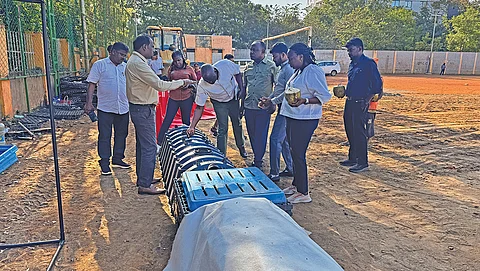

This monsoon could be different for Chennai, which has been in the news for its rapidly vanishing waterbodies and waterlogged roads. Estimates show that the capital of Tamil Nadu has lost over 60 per cent to development projects and illegal encroachments of its wetlands in the past four decades. Moreover, in a changing climate, as rainfall becomes erratic with more violent downpours and worsening dry spells, the paved-over city sees devastating flash floods, such as in 2015. But authorities appear to have found a solution to the nagging self-created water problem by converting green spaces in the city into “sponge parks”.
Sponge parks, somewhat similar to rainwater harvesting structures, are essentially green spaces with a system that allows percolation of rainwater or overflowing stormwater, which is channelised to either replenish aquifers or to rejuvenate nearby waterbodies. This way, they help avert waterlogging and ease impact of flash floods.
The Greater Chennai Corporation (GCC) constructed 57 sponge parks across the city in 2023-24 and has planned for 30 more in 2024-25. These constructions came after two Central programmes—the Scheme for Special Assistance to States for Capital Investment (SSASCI), 2022-23 and the Jal Jeevan Mission (Urban), 2021-22—proposed creating sponge parks to reduce urban floods. In its 2025-26 budget, Tamil Nadu allocated Rs 88 crore for seven more sponge parks in Chennai, under the purview of the National Disaster Management Authority.
One of the sponge parks GCC is currently constructing is at RA Puram corporation playground, near St Mary’s Road in the city centre, which is frequently waterlogged after rains. Chennai-based construction firm Stone Hands Project and Consultancy Private Limited has gotten the contract to develop the sponge park. Its design includes a permeable pavement made of stone chips to allow rainwater to percolate below the surface. Underneath, open drains are constructed to store water using eco-blocks that are made from recycled polymer-based materials and have in-built filtration systems. The drains would be connected to a nearby aquifer. “The stormwater management system made from eco-blocks is fully sustainable, with no signs of pollution. This is a German technology and is being used worldwide,” says a representative of the firm, on condition of anonymity. The firm says similar projects are set up in Ahmedabad.
So far in the country, Chennai and Ahmedabad have set up sponge parks, while Andhra Pradesh has announced a plan for such green spaces in 2023. While the concept may be new to India, it is being implemented in many other countries.
In China, where researcher and landscape architect Kongjian Yu introduced the concept in 2000, the government started with a pilot in 30 cities under its Sponge City Programme in 2014. “Integrated water management approach: The sponge city project in Shenzhen”, a paper published on the website of the UN Economic and Social Commission for Asia and the Pacific (ESCAP), studies the implementation of the programme in Shenzhen. The city, which sees both waterlogging during rainfall and resource shortage in the summers, focused on developing bioretention catchments (rain gardens and ponds) and green belts. Its 150 sq km “spongy” surface now harvests over 70 per cent of stormwater. Similar positive impacts have been noted in Harbin city, Sanya city and even the Lingang Bird Airport in Shanghai.
Copenhagen in Denmark redesigned its infrastructure after heavy floods in 2011 due to a cloudburst. Some 250 public spaces are now modified to retain stormwater and waterbodies are rejuvenated.
In 2023, Germany introduced the “Implementation of Sponge City: Transformation and Sustainable Model Solutions for Roofs of the Blue-Green City”, commonly known as the Hydrotox Research Project, which aims to develop permeable pavements and green infrastructure in Berlin and other cities.
While the setup of sponge parks is encouraging, a study published by UK-based non-profit International Water Association in 2023 suggests the concept has barriers that can reduce its efficiency, such as high initial cost to build and maintain the infrastructure. A 2023 study published in Applied and Computational Engineering says unscientific planning and implementation, noninclusion of local communities can lead to social and economic risks. It says success of one city cannot be guaranteed in another, so environmental factors must be prioritised in planning and implementation.
Senthil Kumar, senior scientist, Central Groundwater Board (CGWB), Tamil Nadu, also highlights the importance of soil conditions. “Such programmes will be suitable and impactful at places having clay soil,” he says. Chennai has mostly clay soil, along with shale and sandstone. “Clay acts as an impermeable layer and hinders passage of stormwater deeper into the ground. In areas with sandy soil, the concept can be modified as per local conditions, since water percolates in the ground naturally,” he says.
Another issue is the quality of stormwater discharged into waterbodies or groundwater. “There should be quality assurance of materials used for construction of permeable pavements and surfaces, as they will interact with stormwater and may affect its physical and chemical parameters. There is a chance of microplastic pollution if plastic materials are used for transport of water,” says T Subramani, professor and head, geology department, Anna University, Chennai.
Experts advocate for improving existing infrastructure for stormwater management. “Sponge parks are a new way of rainwater harvesting with focus on increasing green spaces to absorb excess rainwater. But even simple rejuvenation of waterbodies can absorb excess rainwater,” says Durjoy Chakraborty, former senior scientist, CGWB.
This article was originally published in the June 16-30, 2025 print edition of Down To Earth